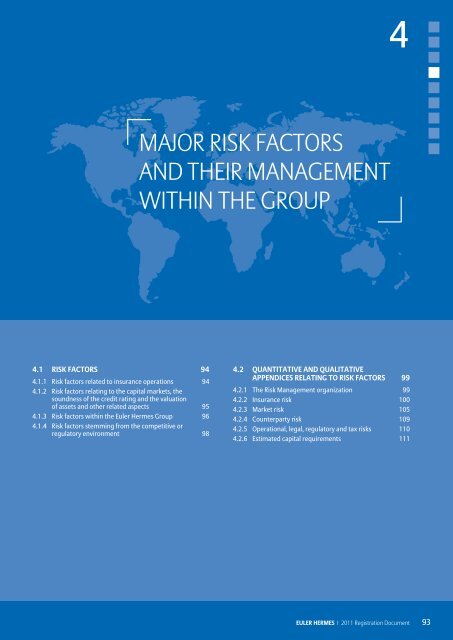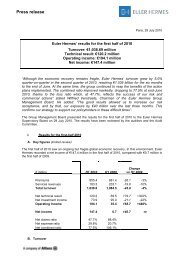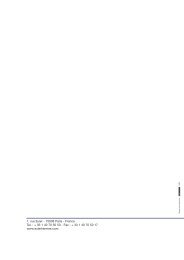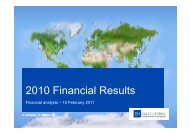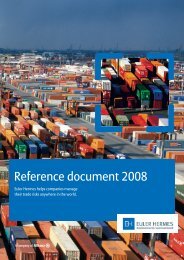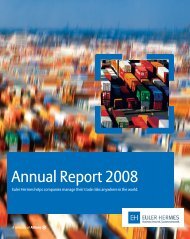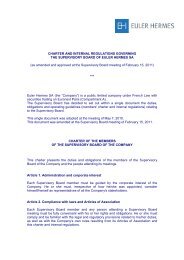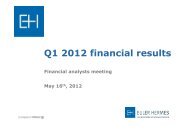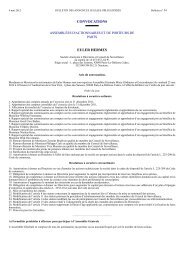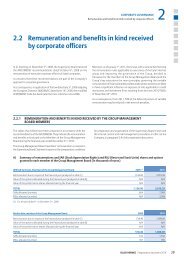major risk factors and their management within the ... - Euler Hermes
major risk factors and their management within the ... - Euler Hermes
major risk factors and their management within the ... - Euler Hermes
You also want an ePaper? Increase the reach of your titles
YUMPU automatically turns print PDFs into web optimized ePapers that Google loves.
4.1 RISK FACTORS 94<br />
4.1.1 Risk <strong>factors</strong> related to insurance operations 94<br />
4.1.2 Risk <strong>factors</strong> relating to <strong>the</strong> capital markets, <strong>the</strong><br />
soundness of <strong>the</strong> credit rating <strong>and</strong> <strong>the</strong> valuation<br />
of assets <strong>and</strong> o<strong>the</strong>r related aspects 95<br />
4.1.3 Risk <strong>factors</strong> <strong>within</strong> <strong>the</strong> <strong>Euler</strong> <strong>Hermes</strong> Group 96<br />
4.1.4 Risk <strong>factors</strong> stemming from <strong>the</strong> competitive or<br />
regulatory environment 98<br />
MAJOR RISK FACTORS<br />
AND THEIR MANAGEMENT<br />
WITHIN THE GROUP<br />
4<br />
4.2 QUANTITATIVE AND QUALITATIVE<br />
APPENDICES RELATING TO RISK FACTORS 99<br />
4.2.1 The Risk Management organization 99<br />
4.2.2 Insurance <strong>risk</strong> 100<br />
4.2.3 Market <strong>risk</strong> 105<br />
4.2.4 Counterparty <strong>risk</strong> 109<br />
4.2.5 Operational, legal, regulatory <strong>and</strong> tax <strong>risk</strong>s 110<br />
4.2.6 Estimated capital requirements 111<br />
EULER HERMES I 2011 Registration Document 93
4 Risk<br />
MAJOR RISK FACTORS AND THEIR MANAGEMENT WITHIN THE GROUP<br />
<strong>factors</strong><br />
4.1 Risk <strong>factors</strong><br />
<strong>Euler</strong> <strong>Hermes</strong> draws readers’ attention to <strong>the</strong> <strong>risk</strong>s described below.<br />
These <strong>risk</strong>s are liable to have a material impact on our operations, our<br />
consolidated net income, our financial position, our share price, our<br />
solvency margin or our ability to achieve expected results.<br />
The description of <strong>risk</strong>s provided below is not exhaustive. O<strong>the</strong>r <strong>risk</strong>s <strong>and</strong><br />
uncertainties that are currently unknown or regarded as minor could, in<br />
<strong>the</strong> future, significantly affect our business, our financial position, our<br />
consolidated net income, our cash flows or our share price.<br />
The <strong>risk</strong>s described below are inherent to <strong>the</strong> nature of <strong>the</strong> Group’s<br />
operations <strong>and</strong> its economic, competitive <strong>and</strong> regulatory environments.<br />
In view of <strong>the</strong> numerous contingencies <strong>and</strong> uncertainties associated with<br />
<strong>the</strong>se <strong>risk</strong>s, <strong>management</strong> is not always able to quantify <strong><strong>the</strong>ir</strong> impact with<br />
accuracy. However, to prevent, detect <strong>and</strong> manage <strong>risk</strong>s on an ongoing<br />
basis, <strong>Euler</strong> <strong>Hermes</strong> has implemented numerous <strong>risk</strong> <strong>management</strong><br />
processes, procedures <strong>and</strong> controls. These processes, like any control <strong>and</strong><br />
monitoring system, cannot be regarded as an absolute guarantee; ra<strong>the</strong>r,<br />
<strong>the</strong>y offer a reasonable assurance of security in respect of operations <strong>and</strong><br />
of control over results.<br />
4.1.1 RISK FACTORS RELATED TO INSURANCE OPERATIONS<br />
The prevailing <strong>and</strong> future economic environment<br />
By its nature, <strong>Euler</strong> <strong>Hermes</strong>’ activity is directly related to economic activity.<br />
The prevailing challenging economic environment has various effects,<br />
some of which may have conflicting impacts:<br />
■ a decline in premiums stemming from a downturn in economic activity,<br />
leading to a reduction in policyholders’ turnover, which is <strong>the</strong> basis for<br />
calculating <strong>the</strong> insurance premium, or a loss of policies (termination<br />
of unprofitable policies by <strong>Euler</strong> <strong>Hermes</strong>, failure of policyholders,<br />
termination by policyholders);<br />
■ a potential increase in premiums resulting from <strong>the</strong> signing of new<br />
policies (new policyholders seeking coverage of <strong><strong>the</strong>ir</strong> client receivables<br />
or existing policyholders extending <strong><strong>the</strong>ir</strong> coverage), or from rate<br />
increases;<br />
■ an increase in <strong>the</strong> frequency of claims <strong>and</strong> a possible increase in severity<br />
claims.<br />
To address this <strong>risk</strong>, <strong>Euler</strong> <strong>Hermes</strong> acts in three ways to reduce <strong>the</strong><br />
sensitivity of its results to <strong>the</strong> economic environment:<br />
■ implementation of more precise monitoring of limits granted, aimed at<br />
limiting <strong>the</strong> losses borne jointly by policyholders, reinsurers <strong>and</strong> <strong>Euler</strong><br />
<strong>Hermes</strong>;<br />
■ diversification of sector <strong>and</strong> geographical <strong>risk</strong>;<br />
■ product diversification through <strong>the</strong> introduction of services less closely<br />
related to economic activity.<br />
94 EULER HERMES I 2011 Registration Document<br />
The Risk Management organization is described in section 4.2 of this<br />
Registration Document. Fur<strong>the</strong>rmore, while <strong>the</strong> <strong>risk</strong>s described in<br />
section 4.1 may have measurable financial consequences or potential<br />
for significant liabilities, <strong>the</strong>se <strong>factors</strong> are reflected in <strong>the</strong> Group’s<br />
consolidated <strong>and</strong> combined financial statements, in accordance with <strong>the</strong><br />
applicable IFRS. The <strong>risk</strong>s described below are classified on <strong>the</strong> basis of<br />
<strong><strong>the</strong>ir</strong> origin. This presentation aims to reflect <strong>management</strong>’s current views<br />
on <strong>the</strong> potential consequences of each <strong>risk</strong> to <strong>the</strong> <strong>Euler</strong> <strong>Hermes</strong> Group.<br />
While <strong>management</strong> devotes significant resources to Risk Management<br />
on an ongoing basis, as described in section 4.2 of this document, <strong>the</strong><br />
Group’s Risk Management activities, like any system of control, are subject<br />
to inherent limits <strong>and</strong> cannot provide absolute certainty or protect <strong>the</strong><br />
Group against <strong>the</strong> <strong>risk</strong>s described in section 4.1, or any losses potentially<br />
caused by <strong>the</strong>se <strong>risk</strong>s.<br />
The persistence of difficult economic conditions may have a negative<br />
impact on <strong>Euler</strong> <strong>Hermes</strong>’ net income, its financial strength, its solvency<br />
margin, its share price <strong>and</strong>, potentially, its reputation.<br />
The occurrence of natural or human disasters,<br />
or <strong>the</strong> consequences of emerging, <strong>and</strong> inherently<br />
unpredictable <strong>risk</strong>s<br />
The proliferation of wea<strong>the</strong>r events worldwide, not to mention o<strong>the</strong>r <strong>risk</strong>s<br />
such as acts of terrorism, explosions, <strong>the</strong> emergence <strong>and</strong> progression of<br />
p<strong>and</strong>emics or <strong>the</strong> impact of future climate change could, in addition to<br />
<strong><strong>the</strong>ir</strong> immediate damage <strong>and</strong> impact, have a material impact on insurers’<br />
operations as well as <strong><strong>the</strong>ir</strong> current <strong>and</strong> future results.<br />
While past experience shows that such events have little impact on <strong>the</strong><br />
Group’s results, <strong>Euler</strong> <strong>Hermes</strong> cannot rule out <strong>the</strong> possibility that such<br />
events could affect its net income in <strong>the</strong> future.<br />
A failure of or change in regulations impacting<br />
<strong>the</strong> process of underwriting insurance <strong>risk</strong>s<br />
The <strong>management</strong> of credit-insurance <strong>risk</strong> <strong>and</strong> sureties is based on a strong<br />
<strong>risk</strong> culture combined with contract <strong>management</strong> <strong>and</strong> client service. In<br />
addition to managing <strong>the</strong> subscription of contracts, <strong>the</strong> Group provides a<br />
service to policyholders to reduce <strong>the</strong> <strong>risk</strong>s weighing on <strong><strong>the</strong>ir</strong> receivables.
As such, during <strong>the</strong> period of insurance, all requests for insurance cover on<br />
a given customer are analyzed in accordance with specific solvency criteria<br />
for <strong>the</strong> customer in question (financial analysis, prior claims). Cover is<br />
<strong>the</strong>n issued on <strong>the</strong> basis of <strong>the</strong> <strong>risk</strong> profile of <strong>the</strong> commercial transaction<br />
associated with <strong>the</strong> request.<br />
Credit-insurance <strong>risk</strong> <strong>management</strong> processes are based on an ability to<br />
analyze <strong>the</strong> solvency of <strong>the</strong> policyholder’s customer on <strong>the</strong> basis of all<br />
information ga<strong>the</strong>red.<br />
The following <strong>factors</strong> are needed to ensure this capacity for analysis:<br />
■ <strong>the</strong> possibility of ga<strong>the</strong>ring or purchasing information about our<br />
policyholders’ customers;<br />
■ <strong>the</strong> correct functioning of a centralized information system ga<strong>the</strong>ring<br />
information <strong>and</strong> requests for cover;<br />
■ <strong>the</strong> establishment <strong>and</strong> consistent application of written rules governing<br />
<strong>the</strong> analysis of information ga<strong>the</strong>red <strong>and</strong> decisions on requests for<br />
cover;<br />
■ <strong>the</strong> enforcement of <strong>the</strong>se rules at two levels: by a central team tasked<br />
with this purpose <strong>and</strong> by <strong>the</strong> internal audit function.<br />
A failure of one of <strong>the</strong> processes or tools in place, or change in <strong>the</strong> statutory<br />
or regulatory requirements under which such operations are carried out<br />
could have an impact on net income or financial strength. They could also<br />
lead to legal or regulatory fines. Lastly, <strong>the</strong>y could have consequences on<br />
<strong>the</strong> Group’s reputation.<br />
The possibility of recording losses in <strong>the</strong> event<br />
of <strong>the</strong> materialization of <strong>the</strong> assumptions used<br />
to determine insurance reserves<br />
Determining insurance reserves, including reserves for premiums not yet<br />
written or reserves for un-notified claims, is based on inherently uncertain<br />
elements derived from assumptions bearing on future change in <strong>factors</strong><br />
that may be (i) economic, demographic, social, legislative, regulatory,<br />
financial, or (ii) linked to <strong>the</strong> conduct of <strong>the</strong> policyholder or his/her<br />
customer.<br />
4<br />
MAJOR RISK FACTORS AND THEIR MANAGEMENT WITHIN THE GROUP<br />
Risk <strong>factors</strong><br />
The use of <strong>the</strong>se numerous assumptions involves a significant amount<br />
of evaluation on <strong>the</strong> part of <strong>the</strong> Group’s governing bodies <strong>and</strong> change<br />
in <strong>the</strong>se assumptions may affect <strong>the</strong> level of reserves, with a negative<br />
impact on <strong>Euler</strong> <strong>Hermes</strong>’ net income, financial position, solvency margin<br />
<strong>and</strong> valuation.<br />
A failure of reinsurers, higher reinsurance<br />
costs or reduced capacity of reinsurers<br />
in <strong>the</strong> credit-insurance market<br />
The <strong>the</strong>oretical exposure granted by <strong>Euler</strong> <strong>Hermes</strong> is not based solely on<br />
<strong>the</strong> Group’s available capital.<br />
The <strong>the</strong>oretical exposure is based on <strong>the</strong> fact that some of <strong>the</strong> claims<br />
arising from this exposure will be transferred to external reinsurers, <strong>the</strong><br />
transfer being purchased to cover a financial year.<br />
It should be borne in mind that <strong>the</strong> act of transferring some of <strong>the</strong> <strong>risk</strong>s<br />
borne by <strong>Euler</strong> <strong>Hermes</strong> to reinsurance companies does not release it from<br />
its obligation to indemnify its policyholders.<br />
In concrete terms, <strong>Euler</strong> <strong>Hermes</strong> is subject to <strong>the</strong> following <strong>risk</strong>s:<br />
i) <strong>the</strong> solvency of one of its reinsurers;<br />
ii) failure to purchase reinsurance treaties at acceptable prices.<br />
<strong>Euler</strong> <strong>Hermes</strong> has implemented <strong>management</strong> rules to assess <strong>the</strong> solvency<br />
of its reinsurers <strong>and</strong> ensure <strong>the</strong> proper diversification of such transfers.<br />
Never<strong>the</strong>less, one or more reinsurers could no longer be able to meet its<br />
commitments, leading to a rise in <strong>Euler</strong> <strong>Hermes</strong>’ own losses.<br />
In addition, reinsurance capacity <strong>and</strong> <strong>the</strong> pricing of reinsurance treaties<br />
depend on <strong>the</strong> prevailing economic conditions, <strong>and</strong> can vary substantially.<br />
As such, <strong>Euler</strong> <strong>Hermes</strong> may have difficulty purchasing reinsurance at<br />
acceptable prices.<br />
The materialization of one of <strong>the</strong>se <strong>risk</strong>s could have a long-term effect on<br />
affect its activity, its net income <strong>and</strong> its solvency margin.<br />
4.1.2 RISK FACTORS RELATING TO THE CAPITAL MARKETS, THE SOUNDNESS OF THE CREDIT RATING<br />
AND THE VALUATION OF ASSETS AND OTHER RELATED ASPECTS<br />
Risks bearing on <strong>the</strong> investment portfolio<br />
The <strong>risk</strong>s described below could, if <strong>the</strong>y materialize, have negative impacts<br />
on current <strong>and</strong> future turnover, net income, cash flows, financial position<br />
<strong>and</strong>, in some cases, <strong>the</strong> <strong>Euler</strong> <strong>Hermes</strong> share price.<br />
i) Interest rate <strong>risk</strong><br />
As its portfolio is invested primarily in bonds (national, supranational <strong>and</strong>,<br />
to a lesser extent, corporate), <strong>Euler</strong> <strong>Hermes</strong> is subject to interest rate <strong>risk</strong>.<br />
During periods of declining interest rates, <strong>the</strong> <strong>risk</strong> is that <strong>the</strong> portfolio’s<br />
average interest rate could fall (reinvestment being made at lower rates)<br />
or that <strong>the</strong> portfolio duration could increase (making <strong>the</strong> portfolio more<br />
susceptible to future changes in interest rates).<br />
During periods of rising interest rates, <strong>the</strong> <strong>risk</strong> is that <strong>the</strong> market value of<br />
<strong>the</strong> bond portfolio could decline, possibly resulting in unrealized losses<br />
or <strong>the</strong> need to write down <strong>the</strong> value of bonds.<br />
<strong>Euler</strong> <strong>Hermes</strong> has implemented an asset <strong>management</strong> policy aimed at<br />
minimizing <strong>the</strong>se <strong>risk</strong>s, including asset-liability <strong>management</strong> factoring<br />
in all local constraints.<br />
EULER HERMES I 2011 Registration Document<br />
95
4 Risk<br />
MAJOR RISK FACTORS AND THEIR MANAGEMENT WITHIN THE GROUP<br />
<strong>factors</strong><br />
ii) Equity market <strong>risk</strong><br />
As it has invested in shares (or <strong><strong>the</strong>ir</strong> equivalent), <strong>Euler</strong> <strong>Hermes</strong> is exposed<br />
to a decline in <strong>the</strong> equity markets which may last for a longer or shorter<br />
period. This could result in <strong>Euler</strong> <strong>Hermes</strong> having to record unrealized<br />
losses or asset impairments.<br />
<strong>Euler</strong> <strong>Hermes</strong> has implemented an asset <strong>management</strong> policy aimed at<br />
selecting high-quality issuers <strong>and</strong> diversifying <strong>risk</strong> in this asset class.<br />
iii) Property <strong>risk</strong><br />
<strong>Euler</strong> <strong>Hermes</strong> is exposed to property <strong>risk</strong>, via <strong>the</strong> buildings housing <strong>the</strong><br />
Group’s operations, as well as its investment properties.<br />
The <strong>risk</strong> is that market values may fall, <strong>the</strong>reby reducing <strong>the</strong> unrealized<br />
capital gains on <strong>the</strong>se buildings or requiring <strong>the</strong> Group to record<br />
unrealized losses.<br />
iv) Counterparty <strong>risk</strong><br />
Losses due to <strong>the</strong> failure of financial institutions <strong>and</strong> third parties, including<br />
potential defaults on or restructuring of sovereign debt, <strong>the</strong> impairment<br />
of invested assets <strong>and</strong> unrealized losses could all affect <strong>the</strong> value of our<br />
investments <strong>and</strong> reduce our profitability.<br />
<strong>Euler</strong> <strong>Hermes</strong> has implemented <strong>management</strong> rules to diversify <strong>risk</strong><br />
(geographic as well as sector) <strong>and</strong> to reduce <strong>the</strong> <strong>risk</strong> of default by investing<br />
in counterparties boasting robust financial health.<br />
The downgrade of ratings of our capacity<br />
to settle claims or our financial strength<br />
Ratings of capacity to settle claims or financial strength have increasingly<br />
become important elements in determining insurance companies’<br />
relative competitive positions. Rating agencies review <strong><strong>the</strong>ir</strong> ratings <strong>and</strong><br />
methodologies on an ongoing basis, <strong>and</strong> can revise <strong><strong>the</strong>ir</strong> ratings at any<br />
time. Accordingly, our current ratings may vary.<br />
In a financial crisis <strong>and</strong> given <strong>the</strong> deteriorating financial markets in recent<br />
months, some rating agencies have downgraded <strong><strong>the</strong>ir</strong> outlook on <strong>the</strong><br />
life insurance industry, <strong>and</strong> have cut <strong>the</strong> ratings of an increasingly large<br />
number of companies. However, St<strong>and</strong>ard & Poor’s AA- rating of <strong>Euler</strong><br />
<strong>Hermes</strong> has remained unchanged even if perspective has been changed<br />
to negative.<br />
4.1.3 RISK FACTORS WITHIN THE EULER HERMES GROUP<br />
The reliance of <strong>the</strong> <strong>Euler</strong> <strong>Hermes</strong> SA holding<br />
company on its subsidiaries to cover its expenses<br />
<strong>and</strong> dividend payments<br />
As a holding company, <strong>Euler</strong> <strong>Hermes</strong> SA does not have its own activity, all<br />
insurance or service activities being carried out by its subsidiaries. As such,<br />
<strong>Euler</strong> <strong>Hermes</strong> SA is dependent on <strong>the</strong> dividends paid by its subsidiaries<br />
96 EULER HERMES I 2011 Registration Document<br />
A ratings downgrade or <strong>the</strong> potential for one, <strong>and</strong>, more importantly, a<br />
move below an AA rating, could have adverse effects on <strong>the</strong> Company, by:<br />
(i) undermining its competitive position;<br />
(ii) preventing it from distributing new insurance policies;<br />
(iii) increasing <strong>the</strong> rate of redemption or termination of existing<br />
insurance policies;<br />
(iv) raising <strong>the</strong> cost of reinsurance;<br />
(v) limiting its access to sources of funding <strong>and</strong>/or increasing <strong>the</strong> cost<br />
of such funding;<br />
(vi) imposing <strong>the</strong> need to provide additional guarantees for certain<br />
contracts;<br />
(vii) having an adverse impact on relations with creditors or trading<br />
counterparties;<br />
(viii) having a significantly adverse impact on public confidence.<br />
Any of <strong>the</strong>se outcomes could have an adverse impact on <strong>Euler</strong> <strong>Hermes</strong>’<br />
operations, liquidity, consolidated net income, turnover <strong>and</strong> financial<br />
position.<br />
Exchange rate fluctuations<br />
<strong>Euler</strong> <strong>Hermes</strong> is exposed to exchange rate fluctuations due to:<br />
■ <strong>the</strong> presence of subsidiaries outside <strong>the</strong> eurozone. The Group’s main<br />
subsidiaries outside <strong>the</strong> eurozone operate in US dollars, pounds sterling<br />
<strong>and</strong> Swiss francs;<br />
■ <strong>the</strong> granting of limits by a subsidiary in a currency that is not <strong>the</strong> said<br />
subsidiary’s reporting currency.<br />
As of December 31, 2011, 32.2% of <strong>the</strong> Group’s turnover was generated<br />
outside <strong>the</strong> eurozone.<br />
To reduce its exposure to exchange rate fluctuations, <strong>Euler</strong> <strong>Hermes</strong> applies<br />
<strong>the</strong> congruence principle (matching of assets <strong>and</strong> liabilities denominated<br />
in a currency o<strong>the</strong>r than that used to keep accounts).<br />
Moreover, <strong>Euler</strong> <strong>Hermes</strong> does not invest in foreign currencies for<br />
speculative purposes.<br />
Lastly, <strong>the</strong> <strong>Euler</strong> <strong>Hermes</strong> Group does not use hedging instruments to guard<br />
against exchange rate fluctuations.<br />
<strong>and</strong> o<strong>the</strong>r funding sources to meet its expenses, including <strong>the</strong> payment<br />
of dividends <strong>and</strong> interest on its debt.<br />
<strong>Euler</strong> <strong>Hermes</strong> SA anticipates that <strong>the</strong> dividends received from its<br />
subsidiaries <strong>and</strong> o<strong>the</strong>r sources of funding will continue to cover <strong>the</strong> costs<br />
it faces as a holding company, i.e. including interest payments on funding<br />
contracts in progress <strong>and</strong> dividends to shareholders.
Due to <strong>the</strong> different <strong>risk</strong> <strong>factors</strong> described in this section, <strong>Euler</strong> <strong>Hermes</strong> may<br />
receive a reduced dividend or no dividend from some of its subsidiaries,<br />
or need to provide some of <strong>the</strong>m with significant financial support, in <strong>the</strong><br />
form of loans or capital contributions, which could significantly impact its<br />
liquidity <strong>and</strong> its ability to pay dividends.<br />
Estimates made by <strong>the</strong> Group <strong>and</strong> its governing<br />
bodies<br />
Determining <strong>the</strong> amount of reserves <strong>and</strong> impairments is based on<br />
periodic assessments <strong>and</strong> estimates of <strong>the</strong> known <strong>and</strong> inherent <strong>risk</strong>s of<br />
each underlying event. These assessments <strong>and</strong> estimates are revised as<br />
conditions change or as new information becomes available.<br />
The Group’s governing bodies, in <strong>the</strong> light of this information <strong>and</strong> in<br />
accordance with <strong>the</strong> principles <strong>and</strong> methods set out in <strong>the</strong> consolidated<br />
financial statements (see Note 2 “IFRS accounting <strong>and</strong> valuation rules”<br />
in <strong>the</strong> notes to <strong>the</strong> consolidated financial statements), analyze, assess<br />
<strong>and</strong> regularly make decisions based on <strong><strong>the</strong>ir</strong> assessment of <strong>the</strong> causes<br />
<strong>and</strong> consequences of change impacting <strong>the</strong> previous estimate of what<br />
constituted an adequate level of reserves <strong>and</strong> impairments.<br />
However, <strong>Euler</strong> <strong>Hermes</strong> cannot guarantee that its governing bodies have<br />
correctly estimated <strong>the</strong> level of impairments <strong>and</strong> reserves recorded in <strong>the</strong><br />
financial statements, <strong>and</strong> that any additional impairments or reserves<br />
will not adversely affect <strong>the</strong> Group’s net income <strong>and</strong> financial position.<br />
A slowdown in <strong>the</strong> growth of <strong>the</strong> Group’s<br />
operations<br />
Growth observed in recent years, both internal <strong>and</strong> external, may, despite<br />
<strong>the</strong> strategic expansion objectives of <strong>the</strong> governing bodies, not continue or<br />
may not be in line with expectations, mainly due to challenging conditions<br />
in <strong>the</strong> financial markets, <strong>the</strong> capital markets <strong>and</strong> change in economic<br />
conditions.<br />
<strong>Euler</strong> <strong>Hermes</strong> has taken initiatives to enter new markets ei<strong>the</strong>r by<br />
exp<strong>and</strong>ing its existing credit-insurance business in new geographical<br />
areas in which <strong>the</strong> Group was not present or where its earlier presence was<br />
only marginal, or in <strong>the</strong> form of new products related to credit insurance,<br />
such as debt recovery for third parties.<br />
Maintaining high levels of expansion could also be made more difficult<br />
by change in existing regulations or tax laws.<br />
An inability of <strong>the</strong> Group to capitalize on its innovative products or its<br />
partnerships <strong>and</strong> new methods of distribution, to deploy <strong>the</strong>m <strong>within</strong> <strong>the</strong><br />
Group <strong>and</strong> develop <strong>the</strong>m in line with its objectives could adversely affect<br />
<strong>the</strong> growth of <strong>Euler</strong> <strong>Hermes</strong>’ business.<br />
The diversity of <strong>the</strong> countries in which<br />
<strong>Euler</strong> <strong>Hermes</strong> operates<br />
<strong>Euler</strong> <strong>Hermes</strong> markets its products <strong>and</strong> services in Europe, North <strong>and</strong><br />
South America, Asia, Turkey, Russia <strong>and</strong> some African countries through<br />
varied legal structures <strong>and</strong> distribution channels, including subsidiaries<br />
with <strong>major</strong>ity or minority stakes, partnerships, joint ventures, agents <strong>and</strong><br />
independent brokers, etc.<br />
4<br />
MAJOR RISK FACTORS AND THEIR MANAGEMENT WITHIN THE GROUP<br />
Risk <strong>factors</strong><br />
The diversity of <strong>the</strong> Group’s international presence exposes it to very<br />
different <strong>and</strong> often very fluctuating economic, financial, regulatory,<br />
commercial, social <strong>and</strong> political environments, which could potentially<br />
affect dem<strong>and</strong> for its products <strong>and</strong> services, <strong>the</strong> value of its investment<br />
portfolio or <strong>the</strong> solvency of its local business partners.<br />
The successful implementation of <strong>the</strong> Group’s overall strategy may be<br />
hampered by <strong>the</strong> environment of some countries in which <strong>Euler</strong> <strong>Hermes</strong><br />
operates, with adverse effects on <strong>the</strong> Group’s net income <strong>and</strong> financial<br />
position.<br />
Existence of unexpected liabilities relating<br />
to discontinued operations <strong>and</strong> expenses<br />
relating to o<strong>the</strong>r off-balance sheet commitments<br />
<strong>Euler</strong> <strong>Hermes</strong> may occasionally keep insurance <strong>and</strong> reinsurance liabilities<br />
or o<strong>the</strong>r off-balance sheet commitments stemming from <strong>the</strong> sale or<br />
liquidation of various activities, or be required to provide guarantees <strong>and</strong><br />
undertake o<strong>the</strong>r off-balance sheet transactions.<br />
If <strong>the</strong> existing reserves for such obligations <strong>and</strong> liabilities are insufficient,<br />
<strong>the</strong> Group may have to record additional expenses that may impact its<br />
net income significantly.<br />
For more information, see Note 33 of <strong>the</strong> Group’s consolidated financial<br />
statements on commitments given <strong>and</strong> received.<br />
Operational failures or inadequacies<br />
<strong>Euler</strong> <strong>Hermes</strong>’ activity is based very heavily on its processes <strong>and</strong><br />
information systems.<br />
As such, <strong>Euler</strong> <strong>Hermes</strong> makes considerable efforts to maintain <strong>and</strong><br />
modernize its information systems <strong>and</strong> <strong>the</strong> efficiency of its processes.<br />
In particular, <strong>Euler</strong> <strong>Hermes</strong> ensures that its processes <strong>and</strong> information<br />
systems are consistent with industry st<strong>and</strong>ards, regulatory st<strong>and</strong>ards,<br />
technological st<strong>and</strong>ards <strong>and</strong> <strong>the</strong> preferences of its policyholders.<br />
However, <strong>Euler</strong> <strong>Hermes</strong> is exposed to operational <strong>risk</strong>s that are inherent to<br />
<strong>the</strong> Group’s business <strong>and</strong> which may be of human, organizational, material<br />
or natural origin, or result from o<strong>the</strong>r events <strong>within</strong> or outside <strong>the</strong> Group.<br />
This operational <strong>risk</strong> may materialize in various ways, chiefly: interruptions<br />
or failures of information systems used by <strong>the</strong> Group, errors, fraud or<br />
malice on <strong>the</strong> part of its employees, policyholders or intermediaries,<br />
non-compliance with internal <strong>and</strong> external regulations, intrusion into<br />
information systems, etc.<br />
While <strong>Euler</strong> <strong>Hermes</strong> strives to achieve better <strong>management</strong> of all of <strong>the</strong>se<br />
operational <strong>risk</strong>s in order to limit <strong><strong>the</strong>ir</strong> potential impact, <strong>the</strong>y could result<br />
in financial losses, a deterioration in <strong>the</strong> Group’s liquidity, disruption of its<br />
activity, regulatory sanctions or damage to its reputation.<br />
EULER HERMES I 2011 Registration Document<br />
97
4 Risk<br />
MAJOR RISK FACTORS AND THEIR MANAGEMENT WITHIN THE GROUP<br />
<strong>factors</strong><br />
4.1.4 RISK FACTORS STEMMING FROM THE COMPETITIVE OR REGULATORY ENVIRONMENT<br />
A highly competitive environment<br />
<strong>Euler</strong> <strong>Hermes</strong> operates in a highly competitive market, in which o<strong>the</strong>r<br />
players are sometimes subject to different regulations, sometimes use<br />
multiple distribution channels <strong>and</strong> sometimes offer more competitive<br />
prices than those of <strong>the</strong> Group. In addition, several products offer an<br />
alternative to credit insurance <strong>and</strong> increase customers’ possibilities in<br />
respect of cover.<br />
In view of this competitive pressure, <strong>Euler</strong> <strong>Hermes</strong> may need to adjust <strong>the</strong><br />
prices of some of its products <strong>and</strong> services or its policy for underwriting<br />
<strong>risk</strong>s, which could affect its ability to maintain or improve profitability <strong>and</strong><br />
adversely affect its net income <strong>and</strong> financial position.<br />
Reinforcement of <strong>and</strong> change in regulations<br />
at <strong>the</strong> local, European <strong>and</strong> international levels<br />
The credit insurance business is subject to specific regulations in different<br />
countries. Changes to <strong>the</strong> laws <strong>and</strong> regulations governing <strong>the</strong> insurance<br />
business could significantly affect <strong>the</strong> conduct of operations <strong>and</strong> <strong>Euler</strong><br />
<strong>Hermes</strong>’ offer of insurance products.<br />
The implementation of <strong>the</strong> Solvency II directive<br />
To implement <strong>the</strong> Solvency II directive, <strong>Euler</strong> <strong>Hermes</strong> has developed a<br />
project structure under <strong>the</strong> authority of <strong>the</strong> Group’s Chief Financial Officer<br />
<strong>and</strong> Chief Risk Officer.<br />
As part of this project, <strong>Euler</strong> <strong>Hermes</strong> has decided to implement an internal<br />
model in conjunction with its reference shareholder in order to model<br />
all of its individual <strong>risk</strong>s, bearing in mind that <strong>the</strong> st<strong>and</strong>ard formula does<br />
not adequately represent <strong>the</strong> Group’s <strong>risk</strong> profile, especially in respect of<br />
credit insurance.<br />
At <strong>the</strong> time of writing, <strong>Euler</strong> <strong>Hermes</strong> could not be assured that its internal<br />
model would obtain approval from <strong>the</strong> regulators supervising <strong>the</strong> Group.<br />
In <strong>the</strong> event of its internal model failing to be approved, <strong>the</strong> application<br />
of <strong>the</strong> st<strong>and</strong>ard formula laid down under Solvency II might take <strong>the</strong> <strong>Euler</strong><br />
<strong>Hermes</strong>’ solvency margin below <strong>the</strong> level consistent with its <strong>risk</strong> profile,<br />
<strong>the</strong>reby requiring <strong>the</strong> Group to carry out a capital increase <strong>and</strong> possibly<br />
resulting in reputational <strong>risk</strong>.<br />
Moreover, as <strong>the</strong> implementing legislation has not yet been finalized, a<br />
number of choices have been made in preparation for implementing <strong>the</strong><br />
directive. There is uncertainty as to <strong>the</strong> validity of <strong>the</strong>se choices, potentially<br />
resulting in additional costs when implementing <strong>the</strong> final version of <strong>the</strong><br />
directive <strong>and</strong> its implementing legislation, or regulatory sanctions if <strong>Euler</strong><br />
<strong>Hermes</strong> is late in implementing <strong>the</strong> said texts.<br />
98 EULER HERMES I 2011 Registration Document<br />
Change in tax laws <strong>and</strong> regulations at <strong>the</strong> local,<br />
European or international levels<br />
Changes in tax legislation in <strong>the</strong> countries in which <strong>Euler</strong> <strong>Hermes</strong> operates<br />
could have an adverse effect on <strong>the</strong> Group’s operations, cash flows <strong>and</strong><br />
net income.<br />
Fur<strong>the</strong>rmore, such changes in tax laws <strong>and</strong> regulations, or lower-thanexpected<br />
or poorly timed operating performances, could cause significant<br />
change to <strong>the</strong> Group’s deferred tax assets, leading to a reduction in <strong>the</strong><br />
value of some tax assets or preventing <strong><strong>the</strong>ir</strong> use.<br />
This situation could have a material adverse impact on <strong>Euler</strong> <strong>Hermes</strong>’ net<br />
income <strong>and</strong> financial position.<br />
Potential change to international accounting<br />
st<strong>and</strong>ards<br />
<strong>Euler</strong> <strong>Hermes</strong>’ consolidated financial statements are drawn up in<br />
accordance with <strong>the</strong> international accounting st<strong>and</strong>ards as adopted by<br />
<strong>the</strong> European Union. International accounting st<strong>and</strong>ards comprise IFRS<br />
(International Financial Reporting St<strong>and</strong>ards) <strong>and</strong> IAS (International<br />
Accounting St<strong>and</strong>ards), toge<strong>the</strong>r with <strong><strong>the</strong>ir</strong> interpretative texts. Cf. Note 2<br />
“IFRS accounting <strong>and</strong> valuation rules” in <strong>the</strong> notes to <strong>the</strong> consolidated<br />
financial statements.<br />
Plans to amend existing st<strong>and</strong>ards are being considered by <strong>the</strong><br />
International Accounting St<strong>and</strong>ards Board (IASB), some of which may have<br />
a significant impact on <strong>the</strong> financial statements of insurance companies<br />
<strong>and</strong> financial institutions. These potential changes could concern both<br />
<strong>the</strong> recognition of <strong>the</strong> Group’s assets <strong>and</strong> liabilities, as well as its income<br />
<strong>and</strong> expenses in <strong>the</strong> consolidated income statement.<br />
The impact of such changes is difficult to assess at this stage, but would<br />
be liable to affect <strong>Euler</strong> <strong>Hermes</strong>’ net income <strong>and</strong> financial position.<br />
The variety of legal systems in <strong>the</strong> countries<br />
in which <strong>the</strong> Group operates<br />
In recent years, <strong>Euler</strong> <strong>Hermes</strong> has accelerated its international expansion<br />
in countries in which judicial dispute resolution systems can differ in terms<br />
of maturity from those that existing in Europe or <strong>the</strong> United States. As such,<br />
<strong>Euler</strong> <strong>Hermes</strong> may find it difficult to take legal action or enforce rulings. In<br />
such a situation, <strong>the</strong> possible legal implications could affect <strong>the</strong> Group’s<br />
operations <strong>and</strong> net income.
4<br />
MAJOR RISK FACTORS AND THEIR MANAGEMENT WITHIN THE GROUP<br />
Quantitative <strong>and</strong> qualitative appendices relating to <strong>risk</strong> <strong>factors</strong><br />
4.2 Quantitative <strong>and</strong> qualitative appendices<br />
relating to <strong>risk</strong> <strong>factors</strong><br />
4.2.1 THE RISK MANAGEMENT ORGANIZATION<br />
The Risk Management function<br />
The responsibilities of <strong>the</strong> Risk Management function are as follows:<br />
■ identify, measure <strong>and</strong> take part in <strong>the</strong> <strong>management</strong> of financial,<br />
insurance <strong>and</strong> operational <strong>risk</strong>s;<br />
■ define <strong>and</strong> monitor appetite for <strong>the</strong>se <strong>risk</strong>s – reinforcement of <strong>the</strong> <strong>risk</strong>reporting<br />
process, limits <strong>and</strong> <strong>the</strong> decision-making processes – in four<br />
dimensions: revenue, value, capital, liquidities;<br />
■ calculate <strong>the</strong> economic capital related to operations. Economic capital is<br />
calculated using an internal model, responsibility for <strong>the</strong> development<br />
of which is shared between <strong>the</strong> Group, for <strong>the</strong> <strong>risk</strong>s associated with <strong>the</strong><br />
insurance business, <strong>and</strong> <strong>the</strong> reference shareholder for all o<strong>the</strong>r <strong>risk</strong>s;<br />
■ carry out <strong>the</strong> approval process with supervisors in preparation for<br />
Solvency 2 <strong>and</strong> <strong>the</strong> Swiss Solvency Test;<br />
■ build a favorable environment in terms of models/indicators/st<strong>and</strong>ards,<br />
but also in respect of culture for <strong>the</strong> different business lines, in order to<br />
ensure that <strong>risk</strong>s are consistent with <strong>the</strong> <strong>risk</strong> appetite validated locally<br />
by <strong>the</strong> Group;<br />
■ more broadly, take all action necessary to provide an effective “second<br />
line of defense” on all <strong>risk</strong>s.<br />
To fulfill <strong>the</strong>se missions, <strong>the</strong> team is fully independent. While it has no<br />
operational function, it is closely associated with <strong>the</strong> Group’s <strong>management</strong><br />
<strong>and</strong> decision-making processes. It relies on o<strong>the</strong>r Group functions, at both<br />
<strong>the</strong> Group <strong>and</strong> local levels, <strong>and</strong> in particular <strong>the</strong> commercial, underwriting<br />
limits, claims <strong>management</strong> <strong>and</strong> financial resources functions.<br />
All activities <strong>and</strong> <strong>the</strong> results of <strong>risk</strong> analysis are subject to regular reporting.<br />
The organization of <strong>the</strong> Risk Management<br />
function<br />
Risk Management is organized around three pillars:<br />
1) <strong>Euler</strong> <strong>Hermes</strong>’ senior <strong>management</strong>:<br />
− defines <strong>and</strong> implements <strong>the</strong> business strategy under delegation from<br />
<strong>the</strong> Supervisory Board <strong>and</strong>/or <strong>the</strong> Group Management Board,<br />
− defines <strong>and</strong> develops internal controls <strong>and</strong> <strong>the</strong> framework of <strong>the</strong> Risk<br />
Management function,<br />
− ensures that activity is consistent with <strong>the</strong> defined <strong>risk</strong> appetite.<br />
The senior <strong>management</strong> relies on various committees to carry out its<br />
tasks, including:<br />
− <strong>the</strong> Risk Committee,<br />
− <strong>the</strong> Investment Committee,<br />
− <strong>the</strong> Reinsurance Committee,<br />
− <strong>the</strong> Sales Committees,<br />
− <strong>the</strong> Risk Underwriting Committees;<br />
2) Risk Management, which is tasked with:<br />
− defining <strong>and</strong> implementing <strong>the</strong> Risk Management system <strong>within</strong> <strong>the</strong><br />
organization, particularly <strong>the</strong> <strong>risk</strong> governance rules,<br />
− ensuring that all <strong>the</strong> legal entities of <strong>the</strong> Group comply with <strong>the</strong>se rules.<br />
The Risk Management function is led by a Chief Risk Officer, who reports<br />
to <strong>the</strong> Chief Financial Officer.<br />
The Chief Risk Officer <strong>and</strong> his/her team act independently <strong>and</strong> have no<br />
operational responsibilities.<br />
The Risk Management function works closely with <strong>the</strong> “Ethics” function<br />
<strong>and</strong> <strong>the</strong> Actuarial department;<br />
3) <strong>the</strong> internal audit function:<br />
− independently <strong>and</strong> objectively verifies that all processes implemented<br />
as part of Risk Management are properly defined <strong>and</strong> implemented,<br />
<strong>and</strong> suggests improvements.<br />
The local Risk Management function<br />
Risk Management in <strong>the</strong> various legal entities has <strong>the</strong> same tasks <strong>and</strong> is<br />
organized in <strong>the</strong> same way as at Group level.<br />
In particular, each legal entity defines a local <strong>risk</strong> appetite, in line with<br />
<strong>the</strong> Group <strong>risk</strong> appetite, <strong>and</strong> manages its activity on <strong>the</strong> basis of a local<br />
<strong>risk</strong> appetite.<br />
EULER HERMES I 2011 Registration Document<br />
99
4 Quantitative<br />
MAJOR RISK FACTORS AND THEIR MANAGEMENT WITHIN THE GROUP<br />
<strong>and</strong> qualitative appendices relating to <strong>risk</strong> <strong>factors</strong><br />
The main Risk Management flows<br />
The various types of <strong>risk</strong>, identified <strong>and</strong> classified by category <strong>and</strong> function toge<strong>the</strong>r with <strong>the</strong> related control flows, are presented in <strong>the</strong> following diagram:<br />
ASSESSMENT<br />
OF RISK<br />
MAIN<br />
CATEGORIES<br />
RISKS<br />
COMMITTEES<br />
AND CONTROL<br />
TOOLS<br />
AND REPORTING<br />
Market <strong>and</strong> credit<br />
<strong>risk</strong>s<br />
Share Rates<br />
Real estate<br />
Finance committee<br />
Asset/liability<br />
<strong>management</strong>. Capital<br />
<strong>risk</strong> measurements<br />
This structure aims to identify <strong>and</strong> proactively monitor all <strong>risk</strong>s by<br />
maintaining responsibility for <strong><strong>the</strong>ir</strong> <strong>management</strong> at <strong>the</strong> operational level.<br />
This allows routine Risk Management to be spread across <strong>the</strong> operations of<br />
<strong>the</strong> entire Group, while at <strong>the</strong> same time allowing <strong>the</strong> function to respond<br />
to specific events as efficiently as possible. The Group Risk Office prepares<br />
<strong>risk</strong> reports in collaboration with <strong>the</strong> operational functions in order to keep<br />
<strong>management</strong> informed. Committees are important channels, as centers<br />
4.2.2 INSURANCE RISK<br />
Product approval<br />
100 EULER HERMES I 2011 Registration Document<br />
Reinsurance<br />
Credit <strong>risk</strong>s<br />
Reinsurance<br />
committee<br />
Capital <strong>risk</strong>.<br />
Risk measurement<br />
<strong>management</strong><br />
Assessment of <strong>risk</strong>s<br />
<strong>and</strong> control<br />
Counterparty<br />
<strong>and</strong> insurance <strong>risk</strong>s<br />
Subscription<br />
<strong>risk</strong><br />
Product/subscription,<br />
high <strong>risk</strong> <strong>and</strong> commercial<br />
High-<strong>risk</strong> insurance<br />
<strong>management</strong><br />
<strong>Euler</strong> <strong>Hermes</strong> has set up a group-level Product Committee responsible for<br />
approving all new products or changes to existing products.<br />
The Product Committee comprises <strong>the</strong> Group’s main functions, especially<br />
marketing, commercial underwriting, <strong>risk</strong> underwriting, <strong>management</strong><br />
control, reinsurance <strong>and</strong> <strong>risk</strong> <strong>management</strong>.<br />
The Committee’s purpose is to approve products from different<br />
perspectives (commercial, internal processes, profitability, impact on<br />
solvency, etc.) <strong>and</strong> to make a recommendation to <strong>the</strong> Group Management<br />
Board.<br />
Underwriting of <strong>the</strong> <strong>risk</strong><br />
The underwriting of <strong>the</strong> <strong>risk</strong> is done in two phases<br />
Reserve<br />
<strong>risk</strong><br />
AREAS COVERED BY THE RISK COMMITTEE<br />
Actuarial committee<br />
Internal model<br />
on insurance <strong>risk</strong><br />
<strong>and</strong> o<strong>the</strong>r actuarial<br />
models<br />
■ Assessment of <strong>risk</strong> ■ Control including <strong>the</strong> <strong>risk</strong> function ■ Main tools & reporting<br />
Business <strong>risk</strong><br />
Local <strong>and</strong> Group<br />
controls<br />
Cost <strong>and</strong> business<br />
reporting<br />
Operational<br />
<strong>and</strong> legal <strong>risk</strong>s<br />
Business continuity<br />
/legal/IT/regulatory<br />
Business continuity<br />
/SOX committee<br />
Reporting/analysis<br />
<strong>and</strong> self-assessment<br />
of responsibility <strong>and</strong> decision-making for Risk Management, but also in<br />
spreading a culture of <strong>risk</strong> awareness <strong>and</strong> identifying <strong>the</strong> strengths <strong>and</strong><br />
weaknesses of <strong>the</strong> <strong>risk</strong> <strong>management</strong> process. All <strong>the</strong>se elements combine<br />
to form an ongoing <strong>risk</strong> <strong>management</strong> mechanism that includes a forwardlooking<br />
view of <strong>major</strong> <strong>risk</strong>s, especially with regard to any changes in <strong>the</strong><br />
environment or trends. As such, <strong>Euler</strong> <strong>Hermes</strong> is particularly well prepared<br />
to monitor adverse developments <strong>and</strong> take appropriate action.<br />
a) <strong>the</strong> signature of <strong>the</strong> insurance contract<br />
The credit insurance contract contains all <strong>management</strong> rules <strong>and</strong><br />
parameters of <strong>the</strong> relationship between <strong>Euler</strong> Herrmes <strong>and</strong> <strong>the</strong><br />
policyholder (deductible, maximum liability,…). These rules <strong>and</strong><br />
parameters are differentiated depending on <strong>the</strong> <strong>risk</strong> profile of each<br />
policyholder. The functionning of <strong>the</strong> contract is based on <strong>the</strong> declaration<br />
by <strong>the</strong> policyholder of <strong>the</strong> unpaid invoices he has emitted according to a<br />
certain declaration term <strong>and</strong>, during <strong>the</strong> insurance period, <strong>the</strong> exchanges<br />
between <strong>Euler</strong> <strong>Hermes</strong> <strong>and</strong> <strong>the</strong> policyholder are regular in order to<br />
manage <strong>the</strong> most adequately as possible <strong>the</strong> list of gr<strong>and</strong>ted limits. The<br />
principle of global coverage of <strong>the</strong> turnover of <strong>the</strong> policyholder is one of<br />
<strong>the</strong> key element in order to increase <strong>the</strong> diversification of <strong>the</strong> <strong>risk</strong> <strong>and</strong><br />
avoid anti-selection phenomenon<br />
b) <strong>the</strong> <strong>management</strong> of granted limits<br />
<strong>Euler</strong> <strong>Hermes</strong> has implemented a <strong>risk</strong> business model in order to face in<br />
<strong>the</strong> most efficient way <strong>the</strong> insurance <strong>risk</strong>
Key elements of this <strong>risk</strong> business model are:<br />
■ its definition by <strong>the</strong> Group <strong>and</strong> a local uniform application;<br />
■ a local underwriting of <strong>the</strong> limits;<br />
■ a periodic control at group level;<br />
■ processes to buy or collect information on <strong>the</strong> clients of our policyholders<br />
(debtors);<br />
■ a Group grading system;<br />
■ specialized teams;<br />
1. THE COUNTRY OF THE POLICYHOLDER’S CUSTOMER<br />
4<br />
MAJOR RISK FACTORS AND THEIR MANAGEMENT WITHIN THE GROUP<br />
Quantitative <strong>and</strong> qualitative appendices relating to <strong>risk</strong> <strong>factors</strong><br />
(in € million) 2011 % 2010 % Variation<br />
Total Europe 585,493 83.4% 538,896 85.2% 8.6%<br />
of which : France 189,571 27.0% 186,676 29.5% 1.6%<br />
United-Kingdom 50,436 7.2% 44,763 7.1% 12.7%<br />
Germany 134,099 19.1% 123,326 19.5% 8.7%<br />
Italy 68,340 9.7% 59,186 9.4% 15.5%<br />
Belgium Luxembourg 14,365 2.1% 13,313 2.1% 7.9%<br />
Ne<strong>the</strong>rl<strong>and</strong>s 20,193 2.9% 18,144 2.9% 11.3%<br />
Spain 20,546 2.9% 17,468 2.8% 17.6%<br />
Eastern Europe 33,513 4.8% 26,114 4.1% 28.3%<br />
Sc<strong>and</strong>inavia 23,456 3.3% 22,271 3.5% 5.3%<br />
O<strong>the</strong>r Europe 30,974 4.4% 27,635 4.4% 12.1%<br />
Total Americas 70,874 10.1% 56,180 8.9% 26.2%<br />
of which: United States 46,241 6.6% 37,494 5.9% 23.3%<br />
Canada 7,819 1.1% 6,521 1.0% 19.9%<br />
O<strong>the</strong>r Americas 16,814 2.4% 12,165 1.9% 38.2%<br />
Asia-Oceania 32,659 4.6% 26,498 4.2% 23.3%<br />
Middle East 8,036 1.1% 5,969 0.9% 34.6%<br />
Africa 5,294 0.8% 5,012 0.8% 5.6%<br />
TOTAL 702,356 100.0% 632,555 100.0% 11.0%<br />
2. THE SECTOR OF THE POLICYHOLDER’S CUSTOMER<br />
■ a centralized IT system in which all policyholders requests are entered,<br />
<strong>and</strong> all granted limits <strong>and</strong> any information on <strong>the</strong> debtors are stored.<br />
This unique IT system also controls any incoming <strong>and</strong> outcoming<br />
information;<br />
■ quality st<strong>and</strong>ard for <strong>the</strong> services provided to our policyholders.<br />
The following table sets out <strong>the</strong> <strong>Euler</strong> <strong>Hermes</strong> Group’s gross <strong>the</strong>oretical<br />
exposure in two ways:<br />
1) <strong>the</strong> country in which <strong>the</strong> policyholder’s customer is located; (1)<br />
2) <strong>the</strong> economic sector to which <strong>the</strong> policyholder’s customer belongs.<br />
(in € million) 2011 % 2010 En % var<br />
Automotive 24,624 3.5% 20,024 3.2% 23.0%<br />
Chemicals 43,349 6.2% 37,171 5.9% 16.6%<br />
Commodities 41,455 5.9% 35,225 5.6% 17.7%<br />
Computers & Telecoms 17,105 2.4% 15,703 2.5% 8.9%<br />
Construction 101,883 14.5% 96,843 15.3% 5.2%<br />
Electronics 34,036 4.8% 28,856 4.5% 18.0%<br />
Food 72,897 10.4% 64,265 10.1% 13.4%<br />
Household equipement 29,522 4.2% 26,899 4.3% 9.8%<br />
IT Services 13,117 1.9% 11,316 1.8% 15.9%<br />
Machinery & Equipment 45,184 6.4% 41,029 6.5% 10.1%<br />
Metal 64,802 9.2% 54,063 8.5% 19.9%<br />
Paper 14,653 2.1% 14,373 2.3% 1.9%<br />
Retail 101,866 14.5% 95,586 15.1% 6.6%<br />
Services 59,878 8.5% 53,268 8.4% 12.4%<br />
Textile 16,640 2.4% 14,789 2.3% 12.5%<br />
Transport 18,088 2.6% 15,799 2.5% 14.5%<br />
Unknown 3,257 0.5% 7,346 1.2% -55.7%<br />
TOTAL 702,356 100.0% 632,555 100.0% 11.0%<br />
(1) <strong>Euler</strong> <strong>Hermes</strong> covers <strong>the</strong> <strong>risk</strong> of non-payment of an invoice issued by a policyholder to its customer. As such, <strong>the</strong> relevant focus of analysis is not <strong>the</strong> policyholder but <strong>the</strong> policyholder’s<br />
customer.<br />
EULER HERMES I 2011 Registration Document<br />
101
4 Quantitative<br />
Reinsurance<br />
MAJOR RISK FACTORS AND THEIR MANAGEMENT WITHIN THE GROUP<br />
<strong>and</strong> qualitative appendices relating to <strong>risk</strong> <strong>factors</strong><br />
The purchase of reinsurance is an important part of <strong>the</strong> <strong>management</strong> of<br />
<strong>the</strong> Group’s insurance activity <strong>and</strong> <strong>the</strong> control of its <strong>risk</strong>s.<br />
<strong>Euler</strong> <strong>Hermes</strong> has entrusted <strong>the</strong> purchase of reinsurance to its Switzerl<strong>and</strong>based<br />
reinsurance company (EH Ré AG).<br />
Rules have been laid down to guide <strong>the</strong> purchase of reinsurance, <strong>and</strong> <strong><strong>the</strong>ir</strong><br />
application is subject to regular internal auditing.<br />
In addition, a Reinsurance Committee comprising <strong>the</strong> Group Chief<br />
Executive Officer, Group Chief Financial Officer, EH Ré AG Chief Executive<br />
Officer <strong>and</strong> Group Risk Officer makes a recommendation to <strong>the</strong> Group<br />
Management Board.<br />
The placement is preceded by:<br />
■ quantitative analysis to ensure that <strong>the</strong> proposed structures match <strong>the</strong><br />
<strong>risk</strong> borne by <strong>Euler</strong> <strong>Hermes</strong>, in terms of both frequency <strong>and</strong> severity,<br />
especially in <strong>the</strong> event of changes in <strong>the</strong> economic conditions in which<br />
<strong>Euler</strong> <strong>Hermes</strong> operates;<br />
■ analysis of <strong>the</strong> financial strength of reinsurers on <strong>the</strong> panel.<br />
Underwriting <strong>and</strong> claims <strong>management</strong><br />
One of <strong>the</strong> responsibilities of <strong>the</strong> subsidiaries as part of <strong><strong>the</strong>ir</strong> insurance<br />
activities is to establish reserves to cover <strong>the</strong> occurrence of an incident<br />
resulting in an insurance claim. These reserves must be sufficient to<br />
guarantee <strong>the</strong> settlement of future claims.<br />
To ensure <strong>the</strong> proper functioning of this process, <strong>Euler</strong> <strong>Hermes</strong> has<br />
developed <strong>and</strong> implemented written procedures for:<br />
■ claims <strong>management</strong>, setting out in particular <strong>the</strong> conditions for<br />
opening <strong>and</strong> settling a claim;<br />
■ <strong>management</strong> of claims recoveries (both before <strong>and</strong> after settlement);<br />
■ recognition of all transactions associated with determining <strong>the</strong> ultimate<br />
loss recorded by <strong>Euler</strong> <strong>Hermes</strong>.<br />
These rules are subject to regular review by <strong>the</strong> Group Claims department<br />
<strong>and</strong> periodic review by <strong>the</strong> Internal Audit department.<br />
The process applies to each notified claim.<br />
<strong>Euler</strong> <strong>Hermes</strong> has implemented a process of defining IBNR reserves<br />
covering un-notified claims relating to <strong>the</strong> current financial year. For <strong>the</strong><br />
definition of this reserve, see <strong>the</strong> following section.<br />
102 EULER HERMES I 2011 Registration Document<br />
Assessment of reserves<br />
Claims reserves recorded at a given time result from three reserves:<br />
■ reserves for notified claims, covering notified claims;<br />
■ IBNR reserves, covering un-notified claims relating to <strong>the</strong> current year;<br />
■ expectations of future recoveries of settled claims.<br />
The reserve for notified claims is subject to case-by-case analysis, as<br />
described in <strong>the</strong> preceding paragraph.<br />
The determination of <strong>the</strong> IBNR reserves <strong>and</strong> expectations of future<br />
recoveries of settled claims result from periodic actuarial analysis<br />
conducted by <strong>the</strong> Actuarial departments of each legal entity <strong>and</strong> overseen<br />
by <strong>the</strong> Group Actuarial department.<br />
The Group Actuarial department is also tasked with ensuring that <strong>the</strong><br />
overall level of <strong>the</strong> Group’s reserves is sufficient to cover future claims, <strong>and</strong><br />
to establish <strong>and</strong> verify <strong>the</strong> correct implementation of actuarial principles,<br />
with which <strong>the</strong> calculations of estimated reserves must be consistent.<br />
The entire process is subject to periodic review by <strong>the</strong> Internal Audit<br />
department <strong>and</strong> by external auditors.<br />
The rules for establishing reserves are consistent with local laws <strong>and</strong><br />
regulations.<br />
At <strong>the</strong> current time, <strong>the</strong> main actuarial methodologies used by <strong>the</strong><br />
Group’s subsidiaries are those based on claims triangles (Chain Ladder,<br />
Bootstrapping methodology, etc.) or o<strong>the</strong>r methodologies (Bornhuetter<br />
Fergusson, etc.). These methodologies aim to define a reasonable range of<br />
estimates <strong>within</strong> which <strong>the</strong> Actuarial departments set <strong><strong>the</strong>ir</strong> recommended<br />
loss ratios.<br />
On <strong>the</strong> basis of this range, calculated by actuaries, <strong><strong>the</strong>ir</strong> recommendations<br />
<strong>and</strong> o<strong>the</strong>r analysis (actuarial or not), <strong>management</strong> sets <strong>the</strong> level of<br />
reserves to be adopted for each quarterly closing during meetings of <strong>the</strong><br />
Loss Reserve Committees. Loss Reserve Committee meetings are held in<br />
each subsidiary <strong>and</strong> <strong>the</strong>n at Group level. They are held at least once per<br />
quarter, but can be called in <strong>the</strong> event of a <strong>major</strong> event requiring a <strong>major</strong><br />
revision to <strong>the</strong> level of reserves (especially a <strong>major</strong> claim).<br />
It should never<strong>the</strong>less be noted that <strong>the</strong> estimates are based mainly on<br />
assumptions that may differ from subsequent observations, particularly<br />
in <strong>the</strong> event of change in <strong>the</strong> economic <strong>and</strong> legal environments, especially<br />
if <strong>the</strong>y simultaneously affect <strong>the</strong> Group’s main portfolios.<br />
A description of <strong>the</strong> main <strong>factors</strong> governing change in claims is provided<br />
in chapter 3.3 of this document.
CLAIMS/PREMIUMS RATIO<br />
4<br />
MAJOR RISK FACTORS AND THEIR MANAGEMENT WITHIN THE GROUP<br />
Quantitative <strong>and</strong> qualitative appendices relating to <strong>risk</strong> <strong>factors</strong><br />
2004 2005 pro-forma 2006 2007 2008 2009 2010 2011<br />
Claims/Premiums Ratio (1) 45.9% 44.8% 49.2% 48.1% 78.1% 82.1% 42.1% 45.1%<br />
(1) In accordance with IFRS.<br />
COST OF CLAIMS FOR GROUP EULER HERMES<br />
(in € thous<strong>and</strong>s)<br />
2011 2010<br />
Gross Reinsurance Net Gross Reinsurance Net<br />
Cost of claims for <strong>the</strong> current period 1,198,907 (350,946) 847,961 1,092,840 (334,480) 758,360<br />
of which, claims paid 253,231 (72,787) 180,444 227,949 (85,783) 142,166<br />
of which, claims reserves 868,086 (273,537) 594,549 775,381 (244,264) 531,117<br />
of which, claims h<strong>and</strong>ling expenses 77,590 (4,622) 72,968 89,510 (4,433) 85,077<br />
Recoveries for <strong>the</strong> current period (112,516) 28,192 (84,324) (128,609) 45,423 (83,186)<br />
Recoveries received (9,925) 3,300 (6,625) (39,998) 27,171 (12,827)<br />
Change in reserves for recoveries (102,591) 24,892 (77,699) (88,611) 18,252 (70,359)<br />
Cost of claims from prior periods (288,523) 80,953 (207,570) (269,805) 68,741 (201,064)<br />
of which, claims paid 515,789 (155,751) 360,038 694,617 (205,924) 488,693<br />
of which, claims reserves (804,415) 238,944 (565,471) (954,615) 273,359 (681,256)<br />
of which, claims h<strong>and</strong>ling expenses 103 (2,240) (2,137) (9,807) 1,306 (8,501)<br />
Recoveries from prior periods (11,510) 6,297 (5,213) 10,373 (4,209) 6,164<br />
Recoveries received (140,860) 31,345 (109,515) (153,865) 30,220 (123,645)<br />
Change in reserves for recoveries 129,350 (25,048) 104,302 164,238 (34,429) 129,809<br />
COST OF CLAIMS 786,358 (235,504) 550,854 704,799 (224,525) 480,274<br />
TECHNICAL RESERVES FOR GROUP EULER HERMES<br />
(in € thous<strong>and</strong>s)<br />
12/31/2011 12/31/2010<br />
Gross Reinsurance Net Gross Reinsurance Net<br />
Claims reserves gross of recoveries 1,625,729 (509,643) 1,116,086 1,557,083 (470,718) 1,086,365<br />
Current period 923,395 (278,818) 644,577 819,386 (247,103) 572,283<br />
Prior periods 702,334 (230,825) 471,509 737,697 (223,615) 514,082<br />
Recoveries to be received (202,858) 51,880 (150,978) (229,888) 51,958 (177,930)<br />
Current period (103,123) 26,861 (76,262) (89,986) 19,163 (70,822)<br />
Prior periods (99,735) 25,019 (74,716) (139,902) 32,795 (107,107)<br />
CLAIMS RESERVES 1,422,871 (457,763) 965,108 1,327,195 (418,760) 908,435<br />
EULER HERMES I 2011 Registration Document<br />
103
4 Quantitative<br />
MAJOR RISK FACTORS AND THEIR MANAGEMENT WITHIN THE GROUP<br />
<strong>and</strong> qualitative appendices relating to <strong>risk</strong> <strong>factors</strong><br />
BREAKDOWN BY TYPE OF RESERVE<br />
(in € thous<strong>and</strong>s)<br />
104 EULER HERMES I 2011 Registration Document<br />
12/31/2011 12/31/2010<br />
Gross Reinsurance Net Gross Reinsurance Net<br />
Reserves for unearned premiums 311,752 (53,418) 258,334 303,689 (50,510) 253,179<br />
Claims reserves 1,422,871 (457,763) 965,108 1,327,195 (418,760) 908,435<br />
of which, reserves for known claims 995,738 (351,103) 644,635 922,871 (313,706) 609,165<br />
of which, reserves for late claims 530,033 (147,027) 383,006 532,256 (146,324) 385,932<br />
of which, reserves for claims h<strong>and</strong>ling expenses 97,273 (11,512) 85,761 94,995 (7,842) 87,153<br />
of which, o<strong>the</strong>r technical reserves 2,685 (1) 2,684 6,960 (2,846) 4,114<br />
of which, recoveries to be received (202,858) 51,880 (150,978) (229,887) 51,958 (177,929)<br />
No-claims bonuses <strong>and</strong> rebates 164,642 (34,780) 129,862 150,510 (31,094) 119,416<br />
TECHNICAL RESERVES 1,899,265 (545,961) 1,353,304 1,781,394 (500,364) 1,281,030<br />
Claims developments:<br />
For a specific attachement year, <strong>the</strong> claims developments follow <strong>the</strong> process of claims declaration, payment <strong>and</strong> recovery. This process can run over<br />
many years.<br />
The below tables represent :<br />
A) THE DEVELOPMENT OF ULTIMATE CLAIMS PER ATTACHEMENT AND DEVELOPMENT YEAR :<br />
ESTIMATE OF THE FINAL COST OF CLAIMS FOR THE DIRECT BUSINESS EXCLUDING ACCEPTANCE OF MOST GROUP ENTITIES (BEFORE<br />
REINSURANCE) (1)<br />
Accident \<br />
development year<br />
(in € thous<strong>and</strong>s) 1 2 3 4 5 6 7 8 9 10 Difference (2) % Diff.<br />
2002 1,071,408 884,309 859,157 831,391 823,041 817,207 806,892 798,807 796,292 795,148 276,260 25.8%<br />
2003 987,024 768,258 701,968 697,434 689,502 683,851 655,673 653,717 650,973 336,051 34.0%<br />
2004 819,859 680,855 635,854 627,541 622,209 615,533 620,348 624,767 195,092 23.8%<br />
2005 841,054 764,392 727,712 726,260 716,066 717,192 708,103 132,951 15.8%<br />
2006 837,028 787,884 743,313 728,431 738,389 736,585 100,443 12.0%<br />
2007 850,433 844,220 830,020 832,520 836,602 13,831 1.6%<br />
2008 1,341,825 1,417,423 1,448,610 1,445,477 -103,652 -7.7%<br />
2009 1,147,801 889,882 855,857 291,944 25.4%<br />
2010 814,878 659,656 155,222 19.0%<br />
2011 991,635 0 0<br />
(1) All figures (Current & Previous years) <strong>and</strong> when necessary have been converted based on <strong>the</strong> End of Year 2011 Euro conversion rate.<br />
(2) Variance: Surplus or shortfall of <strong>the</strong> latest estimated claims cost over <strong>the</strong> initial estimated claims cost for a specific year.
B) THE DEVELOPMENT OF PAID CLAIMS PER ATTACHEMENT AND DEVELOPMENT YEAR :<br />
4<br />
MAJOR RISK FACTORS AND THEIR MANAGEMENT WITHIN THE GROUP<br />
Quantitative <strong>and</strong> qualitative appendices relating to <strong>risk</strong> <strong>factors</strong><br />
DEVELOPMENT TRIANGLES FOR CUMULATIVE CLAIMS PAID NET OF RECOURSE FOR MOST OF THE GROUP ENTITIES (BEFORE<br />
REINSURANCE) (1)<br />
Accident \<br />
development year<br />
(in € thous<strong>and</strong>s) 1 2 3 4 5 6 7 8 9 10<br />
2002 299,574 680,434 771,059 787,813 791,101 790,912 792,359 788,411 788,043 786,593<br />
2003 236,071 558,797 607,631 631,622 638,639 637,332 640,485 640,217 641,653<br />
2004 222,722 535,953 585,793 595,295 597,016 594,399 601,989 603,920<br />
2005 261,665 630,592 674,411 688,247 686,873 688,562 691,165<br />
2006 275,858 657,159 699,425 699,723 719,742 720,605<br />
2007 264,977 699,046 766,590 791,100 801,792<br />
2008 373,757 1,117,982 1,274,998 1,319,850<br />
2009 399,414 721,527 767,405<br />
2010 211,306 499,913<br />
2011 266,719<br />
(1) All figures (Current & Previous years) <strong>and</strong> when necessary have been converted based on <strong>the</strong> End of Year 2011 Euro conversion rate.<br />
4.2.3 MARKET RISK<br />
Market <strong>risk</strong> is <strong>the</strong> <strong>risk</strong> of losses that may result from fluctuations in <strong>the</strong> prices of <strong>the</strong> financial instruments comprising <strong>the</strong> Group’s investment portfolio.<br />
Interest rate <strong>risk</strong><br />
Interest rate <strong>risk</strong> measures <strong>the</strong> sensitivity of <strong>the</strong> value of assets <strong>and</strong> liabilities to changes in <strong>the</strong> interest rate curve.<br />
Interest rate <strong>risk</strong> <strong>management</strong>, while recognizing <strong>the</strong> short duration of <strong>the</strong> liabilities, also takes into account <strong>the</strong> continuity of activity in order to increase<br />
<strong>the</strong> duration of investments <strong>and</strong> thus achieve higher returns on investments in fixed-income products.<br />
12/31/2011 12/31/2010<br />
Bond portfolio broken down by maturity<br />
(in € million) (%) (in € million) (%)<br />
0 to 1 year 462 17% 421 17%<br />
1 to 3 years 777 29% 862 35%<br />
3 to 5 years 734 27% 522 21%<br />
5 to 7 years 375 14% 314 13%<br />
7 to 10 years 306 12% 291 12%<br />
Beyond 10 years 30 1% 55 2%<br />
TOTAL 2,684 100% 2,465 100%<br />
EULER HERMES I 2011 Registration Document<br />
105
4 Quantitative<br />
MAJOR RISK FACTORS AND THEIR MANAGEMENT WITHIN THE GROUP<br />
<strong>and</strong> qualitative appendices relating to <strong>risk</strong> <strong>factors</strong><br />
Exchange rate <strong>risk</strong><br />
Exchange rate <strong>risk</strong> measures <strong>the</strong> sensitivity of assets <strong>and</strong> liabilities<br />
to changes in <strong>the</strong> exchange rates of <strong>the</strong> reporting currency <strong>and</strong> <strong>the</strong><br />
currencies in which assets <strong>and</strong> liabilities are recorded on <strong>the</strong> balance sheet.<br />
<strong>Euler</strong> <strong>Hermes</strong> faces exchange rate <strong>risk</strong> in various ways, mainly with respect<br />
to:<br />
■ limits granted to a policyholder in a currency o<strong>the</strong>r than <strong>the</strong> reporting<br />
currency, potentially leading to change in <strong>the</strong> cash position or <strong>the</strong> levels<br />
of reserves (under <strong>the</strong> procedures of claims h<strong>and</strong>ling or recovery)<br />
recorded in currencies o<strong>the</strong>r than <strong>the</strong> reporting currency;<br />
■ reinsurance in a currency o<strong>the</strong>r than <strong>the</strong> reporting currency;<br />
FINANCIAL PORTFOLIO OF THE GROUP BY CURRENCY<br />
106 EULER HERMES I 2011 Registration Document<br />
■ investment in a currency o<strong>the</strong>r than <strong>the</strong> reporting currency;<br />
■ presence of branches or subsidiaries operating in a currency o<strong>the</strong>r than<br />
<strong>the</strong> reporting currency of <strong>the</strong> parent company.<br />
To limit <strong>the</strong> exchange rate <strong>risk</strong>, <strong>and</strong> in accordance with rules laid down<br />
by local regulators, <strong>the</strong> congruence principle, i.e. <strong>the</strong> matching of assets<br />
<strong>and</strong> liabilities at <strong>the</strong> local level, is applied.<br />
For this reason, <strong>and</strong> because of <strong>the</strong> high level of concentration of activity<br />
in <strong>the</strong> eurozone, <strong>Euler</strong> <strong>Hermes</strong> does not hold any currency hedging<br />
instruments.<br />
As of December 31, 2011, <strong>the</strong> portion of <strong>the</strong> financial portfolio carried by<br />
<strong>the</strong> <strong>Euler</strong> <strong>Hermes</strong> Group in currencies o<strong>the</strong>r than <strong>the</strong> euro amounted to<br />
21.2% of <strong>the</strong> market value of <strong>the</strong> portfolio.<br />
2011 2010<br />
(in € million) (in %) (in € million) (in %)<br />
EUR 2,814 78.8% 2,775 80.2%<br />
GBP 241 6.8% 295 8.5%<br />
USD 276 7.7% 209 6.0%<br />
O<strong>the</strong>r currencies 240 6.7% 182 5.3%<br />
TOTAL 3,571 100% 3,462 100%<br />
Assets comprise <strong>the</strong> investment portfolio, technical reserves recorded as<br />
assets <strong>and</strong> <strong>the</strong> sold portion of technical reserves recorded as liabilities.<br />
Liabilities comprise technical reserves <strong>and</strong> financial liabilities.<br />
Exchange rate <strong>risk</strong><br />
(amounts in € millions)<br />
United States<br />
The principle of matching assets <strong>and</strong> liabilities at <strong>the</strong> local level <strong>and</strong> <strong>the</strong><br />
emphasis on <strong>the</strong> euro in <strong>the</strong> Company’s business has allowed <strong>the</strong> Group<br />
to avoid <strong>the</strong> need of hedging residual exchange-rate <strong>risk</strong>.<br />
2011 2010<br />
United-<br />
Kingdom Group United States<br />
United-<br />
Kingdom Group<br />
Net income attributable to owners of <strong>the</strong> Company<br />
in € thous<strong>and</strong>s at 12.31 8,055 7,316 330,267 21,333 (4,448) 294,452<br />
Exchange rate at year end<br />
Net income attributable to owners of <strong>the</strong> Company<br />
0.7729 1.1972 0.7484 1.1618<br />
in local currency 10,422 6,111 28,505 (3,829)<br />
Variation in exchange rate of 100 basis points (sign of Net result) 0.7629 1.1872 0.7384 1.1718<br />
Net income in € thous<strong>and</strong>s after exchange rate variation 7,951 7,255 330,102 21,048 (4,486) 294,129<br />
% Variation in relation to initial result -1.29% -0.84% -0.05% -1.34% 0.86% -0.11%
Equity market <strong>risk</strong><br />
Equity market <strong>risk</strong> measures <strong>the</strong> sensitivity of <strong>the</strong> value of assets to change<br />
in equity prices. By extension, minority stakes in unlisted companies<br />
<strong>and</strong> investments in funds dominated by equities or convertible bonds<br />
are deemed to be equities. Please notice however that investments in<br />
convertible bonds are classified in <strong>the</strong> category ‘Bonds’ hereunder.<br />
4<br />
MAJOR RISK FACTORS AND THEIR MANAGEMENT WITHIN THE GROUP<br />
Quantitative <strong>and</strong> qualitative appendices relating to <strong>risk</strong> <strong>factors</strong><br />
Approximately 3% of <strong>Euler</strong> <strong>Hermes</strong>’ investment portfolio was in equities<br />
as of end-2011. This percentage is consistent with <strong>the</strong> strategic allocation<br />
of <strong>the</strong> investment portfolio, as well as its tactical allocation, as defined by<br />
<strong>the</strong> Investment Committee.<br />
As of December 31, 2011, <strong>the</strong> maximum proportion of equities allowed<br />
in <strong>the</strong> strategic allocation of <strong>the</strong> investment portfolio was 7,5%.<br />
2011 2010<br />
(in € million) (%) (in € million) (%)<br />
Bonds 2,684.2 69% 2,465 65%<br />
Shares 130.2 3% 142 4%<br />
Real estate investment 12.3 0.3% 23 1%<br />
Loans, deposits <strong>and</strong> o<strong>the</strong>r financial investments 743.8 19% 832 22%<br />
TOTAL FINANCIAL INVESTMENTS 3,570.5 91% 3,462 92%<br />
Cash 347.3 9% 306 8%<br />
TOTAL FINANCIAL INVESTMENTS + CASH 3,917.8 100% 3,768 100%<br />
Liquidity <strong>risk</strong><br />
Liquidity <strong>risk</strong> is <strong>the</strong> <strong>risk</strong> of <strong>Euler</strong> <strong>Hermes</strong>’ financial resources not being<br />
sufficient to cover its cash needs.<br />
Liquidity <strong>risk</strong> is subject to specific monitoring by <strong>the</strong> Group, in both its<br />
insurance activities <strong>and</strong> financial investments.<br />
Each entity carries out projections of <strong>the</strong> cash flows derived from its<br />
insurance operations, its investment portfolio <strong>and</strong> any dividends received<br />
from subsidiaries, <strong>and</strong> <strong>the</strong>n monitors <strong>the</strong>se flows. These cash flow<br />
projections are reviewed during Finance Committee meetings.<br />
With <strong>the</strong> exception of <strong>Euler</strong> <strong>Hermes</strong>’ German entity, which pools cash with<br />
<strong>the</strong> various German entities comprising <strong>the</strong> Allianz Group, Group entities<br />
manage <strong><strong>the</strong>ir</strong> liquidities on an independent basis.<br />
Sources of liquidity available to <strong>Euler</strong> <strong>Hermes</strong> (excluding <strong>the</strong> divestment<br />
of its investment portfolio) are mainly as follows:<br />
■ <strong>the</strong> excess liquidity of a company;<br />
■ shareholders;<br />
■ <strong>the</strong> banking market;<br />
■ <strong>the</strong> bond market.<br />
Based on short- <strong>and</strong> medium-term cash projections <strong>and</strong> stress tests<br />
applied to <strong>the</strong>se projections (liabilities as well as assets), <strong>Euler</strong> <strong>Hermes</strong><br />
considers its liquidity <strong>risk</strong> to be low.<br />
As of December 31, 2011, some of <strong>the</strong> <strong>Euler</strong> <strong>Hermes</strong> Group’s financing<br />
debt (described in Note 17 of chapter 5 of this document) was subject to<br />
specific clauses in addition to st<strong>and</strong>ard clauses relating to <strong>the</strong> existence<br />
of reserves or refusal to certify <strong>the</strong> financial statements, which could lead<br />
to a change in borrowing costs. Indeed, some borrowings are subject to<br />
step-up clauses providing for an increase in <strong>the</strong> annual interest rate in <strong>the</strong><br />
event of a ratings downgrade by St<strong>and</strong>ard & Poor’s.<br />
Real Estate <strong>risk</strong><br />
The real estate <strong>risk</strong> measures <strong>the</strong> sensitivity of <strong>the</strong> value of property<br />
assets to change in <strong>the</strong> market value of <strong>the</strong> real estate. This <strong>risk</strong> covers<br />
<strong>the</strong> buildings housing <strong>the</strong> Group’s operations (described in Note 8 of<br />
chapter 5 of this document), as well as <strong>the</strong> reale estate leased to o<strong>the</strong>r<br />
parties (described in Note 5 to chapter 5 of this document).<br />
Investments in real estate or real estate products (for own use or<br />
investment) account for 6% of <strong>the</strong> market value of <strong>the</strong> investment<br />
portfolio. This percentage is consistent with <strong>the</strong> strategic allocation of<br />
<strong>the</strong> investment portfolio, as well as tactical allocation, as defined by <strong>the</strong><br />
Investment Committee <strong>and</strong> in force as of December 31, 2011.<br />
EULER HERMES I 2011 Registration Document<br />
107
4 Quantitative<br />
Sensitivity tests<br />
MAJOR RISK FACTORS AND THEIR MANAGEMENT WITHIN THE GROUP<br />
<strong>and</strong> qualitative appendices relating to <strong>risk</strong> <strong>factors</strong><br />
In addition to calculating <strong>the</strong> capital required to cover <strong>risk</strong>, <strong>the</strong> Group<br />
performs regular sensitivity tests to ensure <strong>the</strong> consistency of its<br />
protection <strong>and</strong> its sensitivity to scenarios involving heightened <strong>risk</strong>. The<br />
results are illustrative of <strong>the</strong> <strong>risk</strong> under consideration, but <strong>the</strong>y also, like all<br />
Risk of shares <strong>and</strong> bonds in portfolio<br />
(amounts in € million)<br />
108 EULER HERMES I 2011 Registration Document<br />
Market Value at<br />
December 31 st<br />
2011<br />
Impact of<br />
100 basis point<br />
rate rise*<br />
simulations, have limits. The simulation is based on <strong>the</strong> situation at a given<br />
date, <strong>the</strong> year-end in <strong>the</strong> present case. As such, <strong>the</strong> results do not reflect<br />
<strong>the</strong> possibility that events could be managed gradually or ex-post. The<br />
lack of dynamic <strong>management</strong> precludes simulations of all but extreme<br />
cases, with no capacity to adapt positions or structures in <strong>the</strong> event of<br />
significant adverse change.<br />
Impact of 10%<br />
fall in equity<br />
market<br />
Market Value at<br />
December 31 st<br />
2010<br />
Impact of<br />
100 basis point<br />
rate rise**<br />
Impact of 10%<br />
fall in equity<br />
market<br />
Bonds 2,684 (85.4) - 2,465 (81.1) -<br />
Shares 130 - (11.8) 142 - (12.6)<br />
TOTAL 2,814 2,607<br />
* Average sensitivity 3%, calculated on <strong>the</strong> main subsidiaries representing over 99% of <strong>the</strong> bond portfolio at <strong>the</strong> end of 2011.<br />
** Average sensitivity 3%, calculated on <strong>the</strong> main subsidiaries representing over 99% of <strong>the</strong> bond portfolio at <strong>the</strong> end of 2010.<br />
Risk of shares in portfolio at 12/31/2011<br />
(amounts in € million)<br />
Market Value at 12/31/2011/<br />
scenarios impact<br />
Revaluation reserves/<br />
shareholders’ equity impact<br />
Amortized cost/economic<br />
account impact<br />
TOTAL 130 10 120<br />
Impact of 10% fall in equity markets (11.8) (10.2) (1.6)<br />
Impact of 30% fall in equity markets (35.3) (10.2) (25.1)<br />
Shareholders’ equity impact does not take account of deferred taxes. Income impact is before tax<br />
(amounts in € million)<br />
Net Income<br />
2011<br />
Fall in<br />
premiums<br />
-10%<br />
10% rise<br />
in cost of<br />
claims 2011<br />
Increase in<br />
<strong>management</strong><br />
costs of 10%<br />
Net Income<br />
2010<br />
Fall in<br />
premiums<br />
-10%<br />
10% rise<br />
in cost of<br />
claims 2011<br />
Increase in<br />
anagement<br />
costs of 10%<br />
Variation in net income 330 (49) (51) (55) 294 (45) (44) (52)<br />
Financial portfolio at 12/31/2011<br />
(in € million) Assets (a) Liabilities (b)<br />
Engagements<br />
en devises (c)<br />
Net position<br />
before hedging<br />
(d) = (a) – (b) +/- (c)<br />
Hedging<br />
instruments (e)<br />
Net position<br />
after hedging<br />
(f) = (d) – (e)<br />
EUR 2,814 393 0 2,421 0 2,421<br />
GBP 241 0 0 241 0 241<br />
USD 276 0 0 276 0 276<br />
Autres devises 240 0 0 240 0 240<br />
TOTAL 3,571 393 0 3,178 0 3,178<br />
(a) Financial assets.<br />
(b) Borrowings.<br />
12/31/2011<br />
Impact on net income before tax<br />
(in € thous<strong>and</strong>s)<br />
Impact on own funds before tax<br />
(in € thous<strong>and</strong>s)<br />
Rise by 100 bps Fall by 100 bps Rise by 100 bps Fall by 100 bps<br />
GBP 80 (80) 1,273 (1,273)<br />
USD 218 (218) 3,558 (3,558)<br />
TOTAL (GROUP) 298 (298) 4,831 (4,831)
4.2.4 COUNTERPARTY RISK<br />
Counterparty <strong>risk</strong> is <strong>the</strong> loss <strong>Euler</strong> <strong>Hermes</strong> would incur in <strong>the</strong> event of<br />
<strong>the</strong> insolvency of one of its business partners, namely <strong>the</strong> failure of a<br />
reinsurer, a bank, a bond or equity counterparty, or <strong>the</strong> non-execution by<br />
a policyholder of its commitments.<br />
<strong>Euler</strong> <strong>Hermes</strong> has implemented various mechanisms to anticipate <strong>and</strong><br />
limit <strong>the</strong> consequences of <strong>the</strong> failure of one of its counterparties.<br />
Failure of a reinsurer<br />
Mechanisms for detecting <strong>and</strong> limiting counterparty <strong>risk</strong>:<br />
■ selection of reinsurers on <strong>the</strong> basis of <strong><strong>the</strong>ir</strong> counterparties (rated A or<br />
higher or subject to <strong>the</strong> special prior approval of <strong>the</strong> <strong>Euler</strong> <strong>Hermes</strong><br />
Group Management Board in <strong>the</strong> event of <strong>the</strong> rating being below A);<br />
■ limits on concentration <strong>risk</strong> on a single reinsurer;<br />
■ constant monitoring by <strong>the</strong> various operational entities via maturity<br />
analysis of reinsurers’ credits <strong>and</strong> debits, <strong>and</strong> <strong>the</strong> amount of technical<br />
reserves transferred to <strong>the</strong>m;<br />
■ requests for letters of credit or security deposits from reinsurers;<br />
4<br />
MAJOR RISK FACTORS AND THEIR MANAGEMENT WITHIN THE GROUP<br />
Quantitative <strong>and</strong> qualitative appendices relating to <strong>risk</strong> <strong>factors</strong><br />
■ cut-offs of reinsurance treaties a few years after <strong>the</strong> implementation<br />
of <strong>the</strong> reinsurance contract.<br />
In <strong>the</strong> event of <strong>the</strong> failure of a reinsurer or any event that may result in <strong>the</strong><br />
failure of a reinsurer, <strong>the</strong> Company would conduct a <strong>risk</strong> analysis of <strong>the</strong><br />
event. It would <strong>the</strong>n take steps, on <strong>the</strong> basis of its findings, to minimize<br />
<strong>the</strong> negative impact on <strong>Euler</strong> <strong>Hermes</strong>.<br />
In such cases, assets carried by <strong>Euler</strong> <strong>Hermes</strong> in connection with <strong>the</strong><br />
relevant counterparty would be impaired.<br />
16.09%<br />
A<br />
76.66%<br />
AA<br />
DISTRIBUTION OF TECHNICAL PROVISIONS CEDED BY RATING OF REINSURERS (THE PERIMETER COVERED REPRESENTS 93.2% OD THE<br />
PROVISIONS CONSIDERED OUT OF THE GROUP TOTAL AT DECEMBER 31 ST , 2011)<br />
AAA 1,466 0.29%<br />
AA 390,086 76.66%<br />
A 81,852 16.09%<br />
O<strong>the</strong>rs 35,410 6.96%<br />
TOTAL 508,814 100%<br />
Failure of a bank<br />
Mechanisms for detecting <strong>and</strong> limiting counterparty <strong>risk</strong>:<br />
■ selection of banks on <strong>the</strong> basis of <strong><strong>the</strong>ir</strong> rating (rated A or higher);<br />
■ limits on <strong>the</strong> available cash held in bank accounts;<br />
■ increase in <strong>the</strong> number of banks with which companies deal.<br />
In <strong>the</strong> event of <strong>the</strong> failure of a banking counterparty, all <strong>the</strong> Company’s<br />
cash on <strong>the</strong> accounts held by <strong>the</strong> bank in question would be impaired.<br />
Bond portfolio per rating<br />
6.96%<br />
O<strong>the</strong>rs<br />
Failure of a bond or equity counterparty<br />
Mechanisms for detecting <strong>and</strong> limiting counterparty <strong>risk</strong>:<br />
0.29%<br />
AAA<br />
■ Implementation of a strict policy limiting investment in a single private<br />
issuer to 5% of total assets.<br />
December 31st, 2011 December 31st, 2010<br />
(in € million) (%) (in € million) (%)<br />
AAA 1,907 71% 1,679 68%<br />
From AA+ to AA- 167 6% 367 15%<br />
From A+ to A- 320 12% 363 15%<br />
O<strong>the</strong>rs 290 11% 56 2%<br />
TOTAL 2,684 100% 2,465 100%<br />
EULER HERMES I 2011 Registration Document<br />
109
4 Quantitative<br />
MAJOR RISK FACTORS AND THEIR MANAGEMENT WITHIN THE GROUP<br />
<strong>and</strong> qualitative appendices relating to <strong>risk</strong> <strong>factors</strong><br />
Failure of a policyholder<br />
Mechanisms for detecting <strong>and</strong> limiting counterparty <strong>risk</strong>:<br />
■ The Company has established procedures for <strong>the</strong> proactive <strong>management</strong> of funds held with policyholders, in particular to avoid a financial loss in<br />
<strong>the</strong> event of <strong>the</strong> default of a policyholder.<br />
MATURITY<br />
(in € thous<strong>and</strong>s)<br />
Trade receivables are subject to strict monitoring procedures. 99% of trade receivables have a maturity of less than three months. Any outst<strong>and</strong>ing<br />
receivable above six months is fully reserved.<br />
4.2.5 OPERATIONAL, LEGAL, REGULATORY AND TAX RISKS<br />
<strong>Euler</strong> <strong>Hermes</strong>, jointly with its reference shareholder, has implemented<br />
an analysis framework to identify <strong>and</strong> quantify operational <strong>risk</strong> that could<br />
stem from a global failure of <strong>the</strong> organization, from our systems, from<br />
human error or from an external event. Ensuring <strong>the</strong> pertinence of <strong>the</strong><br />
processes implemented to manage <strong>the</strong>se <strong>risk</strong>s is a cornerstone of <strong>the</strong> Risk<br />
Management function.<br />
Operational <strong>risk</strong><br />
The steering of operational <strong>risk</strong> is carried out in accordance with <strong>the</strong><br />
policy laid down in <strong>the</strong> Group’s operational <strong>risk</strong> policy, <strong>and</strong> is based on<br />
<strong>the</strong> deployment <strong>and</strong> maintenance of an appropriate <strong>and</strong> consistent<br />
internal control organization, guaranteeing appropriate operational <strong>risk</strong><br />
<strong>management</strong> for each Group entity.<br />
<strong>Euler</strong> <strong>Hermes</strong>’ operational <strong>risk</strong> <strong>management</strong> system is based on:<br />
■ <strong>the</strong> crisis <strong>management</strong> <strong>and</strong> business continuity plans;<br />
■ <strong>the</strong> definition of internal <strong>management</strong> rules <strong>and</strong> operational procedures<br />
specifying <strong>the</strong> manner in which operations should be carried out;<br />
■ a process of periodic escalation of operating losses above €10,000 <strong>and</strong><br />
a regular analysis of scenarios that could, if <strong>the</strong>y materialize, result in<br />
an operating loss.<br />
The operational <strong>risk</strong> <strong>management</strong> system, set out for all Group entities,<br />
is based on two levels of control, with responsibilities <strong>and</strong> control plans<br />
suited to each level:<br />
■ permanent self-monitoring at <strong>the</strong> operational level <strong>and</strong> continuous<br />
<strong>management</strong> control;<br />
■ periodic checks conducted by each entity’s internal audit function.<br />
In addition, a program covering own insurance <strong>risk</strong>s has been set up in<br />
each <strong>Euler</strong> <strong>Hermes</strong> Group company, in a decentralized manner.<br />
110 EULER HERMES I 2011 Registration Document<br />
Regulatory <strong>risk</strong><br />
December 31st, 2011<br />
< 3 months 3 months to 1 year 1 to 5 years Over 5 years Total<br />
Total credit insurance receivables 530,459 4,668 - - 535,127<br />
The Group is subject to various regulations governing <strong>the</strong> insurance,<br />
banking <strong>and</strong> asset <strong>management</strong> businesses.<br />
The Group is also subject to strict regulations due to its listing on Euronext<br />
Paris.<br />
<strong>Euler</strong> <strong>Hermes</strong> has implemented <strong>the</strong> necessary structures to comply<br />
with <strong>the</strong> regulations of <strong>the</strong> countries in which it operates. They apply <strong>the</strong><br />
laws of <strong><strong>the</strong>ir</strong> country of establishment <strong>and</strong> comply with administrative<br />
requirements or those set by local supervisory authorities, as well as<br />
specific prudential rules.<br />
In particular, each entity has appointed a correspondent tasked with<br />
implementing <strong>the</strong> EU directive on data protection, <strong>and</strong> <strong>the</strong> Group has<br />
streng<strong>the</strong>ned its control over <strong>the</strong> application of regulations by making a<br />
person <strong>within</strong> <strong>the</strong> Group responsible for this function, in conjunction with<br />
correspondents <strong>within</strong> each entity.<br />
Legal <strong>and</strong> arbitration proceedings<br />
In <strong>the</strong> ordinary course of its business, <strong>the</strong> Group is involved in legal actions<br />
(notably debt collection proceedings) <strong>and</strong> is subject to tax assessments<br />
<strong>and</strong> administrative audits. Reserves are systematically established<br />
accordingly.<br />
The unfavourable outcome of any pending or future litigation could<br />
have an adverse impact on <strong>Euler</strong> <strong>Hermes</strong>’ business, financial position,<br />
consolidated net income, reputation or image. <strong>Euler</strong> <strong>Hermes</strong> carefully<br />
manages its relationships with external parties, <strong>and</strong> each entity has a local<br />
structure or <strong>the</strong> necessary legal means to take <strong>the</strong> appropriate action in<br />
<strong>the</strong> event of disputes.<br />
To <strong>the</strong> best of <strong>Euler</strong> <strong>Hermes</strong> knowledge, <strong>the</strong>re are no governmental, judicial<br />
or arbitration proceedings, ei<strong>the</strong>r pending or threatening, which have had<br />
over <strong>the</strong> last twelve months or may in <strong>the</strong> future have a material impact<br />
on <strong>the</strong> financial position or profitability of <strong>the</strong> Company <strong>and</strong>/or Group.
Tax <strong>risk</strong>s<br />
Tax teams at both Group <strong>and</strong> local level monitor change in regulations.<br />
Compliance <strong>risk</strong><br />
Compliance <strong>risk</strong> relates to <strong>the</strong> application of appropriate rules of behavior<br />
for a given period or situation.<br />
To deal with this <strong>risk</strong>, a Group Head of Compliance, working in conjunction<br />
with correspondents in every region, monitors compliance with rules<br />
governing ethics, fraud, money laundering <strong>and</strong> <strong>the</strong> observance of periods<br />
during which trading in <strong>Euler</strong> <strong>Hermes</strong> securities is suspended.<br />
4.2.6 ESTIMATED CAPITAL REQUIREMENTS<br />
As mentioned above, <strong>Euler</strong> <strong>Hermes</strong> has decided to implement an internal<br />
model covering all of <strong>the</strong>se <strong>risk</strong>s, as part of <strong>the</strong> implementation of <strong>the</strong><br />
Solvency II project.<br />
Pending authorization of its internal model, <strong>and</strong> until <strong>the</strong> final calibration<br />
of <strong>the</strong> st<strong>and</strong>ard formula is known, <strong>Euler</strong> <strong>Hermes</strong> produces estimates of its<br />
capital requirements based on <strong>the</strong> latest version of <strong>the</strong> model developed<br />
by St<strong>and</strong>ard & Poor’s.<br />
4<br />
MAJOR RISK FACTORS AND THEIR MANAGEMENT WITHIN THE GROUP<br />
Quantitative <strong>and</strong> qualitative appendices relating to <strong>risk</strong> <strong>factors</strong><br />
Reputational <strong>risk</strong><br />
<strong>Euler</strong> <strong>Hermes</strong> has implemented measures necessary to protect its image<br />
<strong>and</strong> actively communicate to its shareholders, customers, employees <strong>and</strong>,<br />
more broadly, <strong>the</strong> financial community on its financial strength through:<br />
■ regular disclosure, both internally <strong>and</strong> externally;<br />
■ continuous monitoring of our image <strong>and</strong> reputation;<br />
■ a set of rules to determine whe<strong>the</strong>r our operations may result in a<br />
reputational <strong>risk</strong>.<br />
Labor <strong>and</strong> environmental <strong>risk</strong>s<br />
On labor issues, <strong>the</strong> <strong>major</strong> challenge facing <strong>Euler</strong> <strong>Hermes</strong> is how to keep<br />
employees <strong>and</strong> how to attract <strong>the</strong> best talent in <strong>the</strong> future.<br />
On environmental issues, <strong>the</strong> stakes are quite low for <strong>Euler</strong> <strong>Hermes</strong>, due<br />
to <strong>the</strong> generally clean nature of its business.<br />
The model assigns <strong>risk</strong> <strong>factors</strong> to different balance sheet items. As<br />
such, portfolio securities are classified by rating, as well as exposure to<br />
reinsurers. Insurance <strong>and</strong> reserve <strong>risk</strong> is deduced by <strong>the</strong> direct application<br />
of <strong>factors</strong> to net amounts, after reinsurance, of net premiums <strong>and</strong> claim<br />
reserves respectively.<br />
The amounts needed to achieve an A rating, simulated on <strong>the</strong> basis of this method, are presented in <strong>the</strong> following table:<br />
Risk Capital<br />
(in € million) 2011 2010<br />
C1: Market Risk 289 254<br />
C2: Counterparty Risk 57 56<br />
C4: Premiums Risk 1,177 1,083<br />
C5: Reserve Risk 366 319<br />
SIMULATION S&P RAC* 1,889 1,712<br />
* New S&P model simulation for A rating.<br />
The model shows that <strong>Euler</strong> <strong>Hermes</strong>’ <strong>risk</strong> capital requirements increase by<br />
10% compared to 2010. This simulation is based on an internal approach<br />
<strong>and</strong> adjustments potentially made by rating-agency analysts could alter<br />
<strong>the</strong> outcome.<br />
The variation against end of 2010 is mainly driven by:<br />
■ <strong>the</strong> increase of exposure <strong>and</strong> retention rates, which have an impact on<br />
premium <strong>and</strong> reserve <strong>risk</strong>s;<br />
■ <strong>the</strong> increase in investment classified as loans or equivalent creating an<br />
additional charge on <strong>the</strong> market <strong>risk</strong>.<br />
EULER HERMES I 2011 Registration Document<br />
111
4<br />
MAJOR RISK FACTORS AND THEIR MANAGEMENT WITHIN THE GROUP<br />
112 EULER HERMES I 2011 Registration Document


